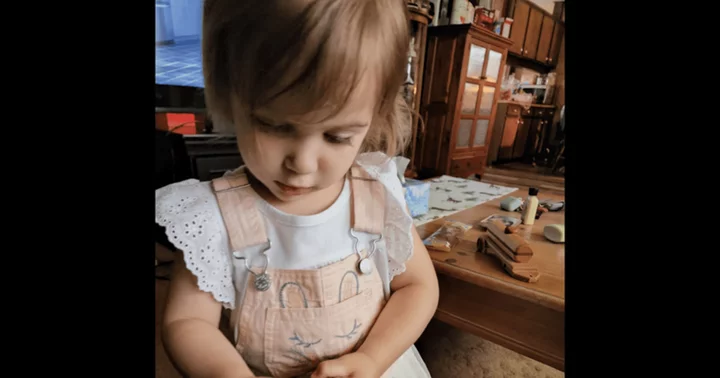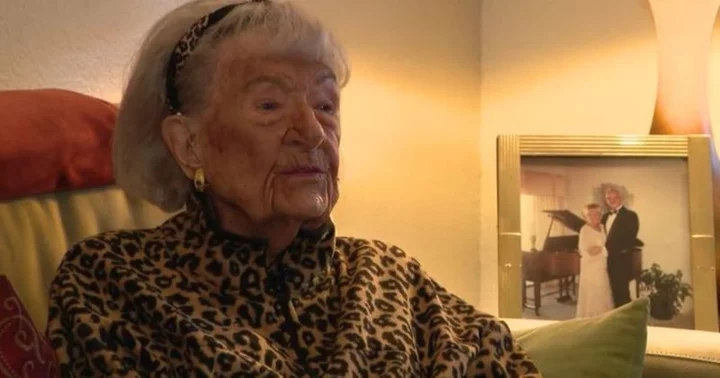The sons of a newly-identified Gilgo Beach murders victim reportedly were not notified by Long Island police before her name was revealed to the public. Suffolk County District Attorney Ray Tierney held a press conference on Friday to announce that the victim known only as Jane Doe 7 had finally been identified as Karen Vergata, more than 26 years after her partial remains were first discovered along the Long Island shores. Vergata, 34, was last seen alive in Manhattan in 1996 while working as an escort. The huge breakthrough in the case comes almost three decades after some of Vergata’s remains were first discovered – and just weeks after Rex Heuermann, a 59-year-old father-of-two architect, was arrested and charged with the murders of three other Gilgo Beach victims. Mr Tierney told reporters that Vergata had been positively identified via DNA in August 2022 but investigators kept the development under wraps due to the ongoing investigation into Mr Heuermann. Officials refused to comment on whether or not her murder may be linked to the suspected serial killer. The district attorney also attributed the delay to the need to contact Vergata’s family members. However, it has since emerged that Vergata’s two biological sons - Eric and Gary Doherty - apparently were not informed before Friday’s announcement. Eric’s girlfriend Michelle Nolan told the New York Post that he only found out after the press conference when they were contacted by the woman who adopted them as young children a few years before Vergata’s death. Ms Nolan said Eric was distraught, having believed that Vergata was only missing. Mr Tierney’s office did not return the Post’s request for comment about family notification, the outlet reported. Ms Nolan said Eric and Gary grew up with little knowledge of their biological mother after having been adopted by Edward and Diane Doherty in 1992. She explained that Vergata had been struck by a truck while she was pregnant with Gary in the late 1980s, which is thought to have led to him being born with cerebral palsy. Shortly after Eric was born in 1990, Vergata “took off”, Ms Nolan said. “She was a drug user and their father took her and helped her,” she said. Ms Nolan said the boys’ father was believed to have died from tuberculosis, but she wasn’t sure when. She said that Gary is now living in an facility for adults with special needs and has not been informed about his mother’s death. Vergata vanished without a trace around 14 February 1996 – Valentine’s Day, according to officials. She lived on West 45th St in Manhattan and is believed to have been working as an escort at the time of her disappearance. Police said that no missing persons report was filed at the time. On 20 April 1996, a woman’s legs were found wrapped in plastic at Davis Park on Fire Island’s Blue Point Beach. Almost exactly 15 years later on 11 April 2011, the woman’s skull was then found off Ocean Parkway during the search for Gilgo Beach victims. The skull was located close to the remains of another unidentified victim – Jane Doe 3, also known as Peaches. The two sets of remains in Fire Island and Ocean Parkway were later found to belong to the same person. Before now, investigators had long been unable to identify Jane Doe 7 – and the victim became known as Fire Island Jane Doe. She was described only as a white woman aged 18 to 50 years old who had several notable scars including evidence of surgery on her left ankle. She was one of 11 victims whose remains were found dumped along the shores of Gilgo Beach back in 2010 and 2011 – several of whom are also yet to be identified. Decades later, investigators were finally able to identify Fire Island Jane Doe using genetic geneaology and her surviving relatives’ DNA. In August 2022 – around six months after the new Gilgo Beach taskforce was launched – a DNA profile suitable for genealogical comparison was developed from the remains of the victim, officials said in a press conference on Friday. The next month, the FBI was able to presumptively identify the victim using genetic genealogy as Vergata. Then, that October, investigators tracked down a relative of Vergata and took a buccal swab. Using this, they were able to definitively identity the victim as Vergata. At Friday’s press conference, Mr Tierney said investigators kept that breakthrough hidden until now due to both the ongoing investigation into Mr Heuermann and the need to contact all of Vergata’s family members. “Prior to disclosing, we needed to contact all Vergata’s family members and around the same time we were beginning the grand jury confidential investigation into the murders of the victims known as the Gilgo 4,” he told reporters. ”So we decided not to make it public... until the results of that investigation became public and we had made notice to Vergata’s family.” He added: “Today we are here to announce that as part of the Gilgo taskforce’s reexamination of all evidence in the case we are able to identify Fire Island Jane Doe as Karen Vergata.” “It is important that we remember and honour not only Ms Vergata but all the vicitms on Gilgo Beach,” he added. While this marks a major breakthrough in the case, many questions still remain. In Friday’s press conference announcing her identity, Suffolk County officials refused to take any questions and would not comment on whether or not Vergata’s murder could be the linked to Mr Heuermann – who has so far been tied to four of the victims found along the Long Island shores. At this time, no one has been charged in connection to her homicide and her cause of death is unknown. DA Tierney said that while there are “no charges at this time”, that the “confidential investigation” is ongoing. He would not confirm or deny any ties to accused killer Rex Heuermann – or say if there was any potential suspects on his radar. “We are going to continue to work this particular case as we did the Gilgo Four investigation,” he said. “We’re not going to comment on what – if any suspects – we developed at this time. This is a confidential investigation so I’m not going to be taking any questions.” This major development comes as prosecutors are seeking to obtain a swab of DNA from Mr Heuermann, the man arrested and charged with the murders of three of the victims and suspected of a fourth killing. In a court filing this week, prosecutors said that the DNA sample would “provide further relevant evidence of the defendant’s identity as the perpetrator of the crime”. Prosecutors have so far obtained hundreds of hours of footage from the suspect’s home in Massapequa Park and his office in Midtown Manhattan, 2,500 pages of documents, crime scene photographs and autopsy reports in the high-profile case. The trove of evidence was turned over to Suffolk County Supreme Court Justice Timothy Mazzei and Mr Heuermann’s attorney Michael Brown on Tuesday as the accused killer appeared in court for a brief preliminary hearing. Suffolk County DA Tierney said last week that a “massive amount of evidence” had been recovered from the home which Mr Heuermann grew up in as a child – and which he went on to share with his family up until his sudden arrest. No human remains were discovered, but a trove of around 270 guns were seized from the home. The DA previously revealed that they believe at least some of the murders may have taken place inside the home. Mr Heuermann’s wife and two adult children were out of town at the time of each of the three murders he is charged with, according to court records. The 59-year-old architect was taken into custody on 13 July, almost 13 years after the bodies of at least 11 victims were discovered along the shores of Gilgo Beach on Long Island. He was charged with the murders of Megan Waterman, Melissa Barthelemy and Amber Costello. He is also the prime suspect in the murder of Maureen Brainard-Barnes – who was last seen alive in early June 2007 in New York City and who, with the three other women, is known as the “Gilgo Four”. All four women worked as sex workers and disappeared after going to meet a client. They were all found in December 2010 within one-quarter mile of each other, bound by belts or tape and some wrapped in burlap – their bodies dumped along Gilgo Beach. They are among 11 victims whose remains were found along the shores of Long Island in 2010 and 2011, sparking fears of one or more serial killers. As well as looking into his connection to the murder of Brainard-Barnes and the other Gilgo Beach victims, law enforcement agencies are now also looking into unsolved murders and missing persons cases all across the country. Police in Las Vegas and South Carolina – where Mr Heuermann owns properties – and Atlantic City – where several sex workers have been found murdered – have confirmed they are eyeing the suspect in cold cases. Court records show that Mr Heuermann was linked to the “Gilgo Four” murders through a tip about his pickup truck, a stash of burner phones, “sadistic” online searches, phone calls taunting victims’ families, his wife’s hair found on the victims’ bodies – and a pizza crust. The first piece of the puzzle came when a witness in the Amber Costello case revealed details about a vehicle that a client was driving when she was last seen alive. Costello, who worked as a sex worker, was seen alive on the evening of 2 September 2010 when she left her home in West Babylon. A witness said she had gone to meet a client who was driving a first-generation Chevrolet Avalanche. Last year, a registration search showed that local man Mr Heuermann owned a first-generation model of the truck at the time of Costello’s disappearance. He also matched the witness’ description of the man believed to be the killer: a large, white “ogre”-like male in his mid-40s, around 6’4’ to 6’6” tall, with “dark bushy hair,” and “big oval style 1970’s type eyeglasses”. The discovery of the car led investigators to hone in on Mr Heuermann including executing 300 subpoenas, search warrants and other legal processes to obtain evidence to determine his potential involvement in the killings. Among this was Mr Heuermann’s alleged use of burner phones, with prosecutors saying that he used burner phones to contact the three women and arrange to meet them at the time when they went missing. He also allegedly took two of the victims’ cellphones – and used one to make taunting phone calls to one of their families where he boasted about her murder, court documents state. Mr Heuermann’s DNA was found on one of the victims, while his wife’s hair was found on three of the four women he is connected to. Following his arrest, his wife Asa Ellerup filed for divorce. She has since told The New York Post that she has been left filled with “anxiety” and their two children “cry themselves to sleep” over the horror. “I woke up in the middle of the night, shivering... anxiety,” she said. “My children cry themselves to sleep. I mean, they’re not children. They’re grown adults but they’re my children, and my son has developmental disabilities and he cried himself to sleep.” Mr Heuermann’s sudden arrest comes after the horrific serial killer case has captured the nation’s attention for more than a decade. The Gilgo Beach murders had long stumped law enforcement officials in Suffolk County who believed it could be the work of one or more serial killers who targeted sex workers and dumped their bodies along the remote beaches on Ocean Parkway. The case began in May 2010 when Shannan Gilbert vanished after leaving a client’s house on foot near Gilgo Beach. She called 911 for help saying she feared for her life and was never seen alive again. During a search for Gilbert in dense thicket close to the beach, police discovered the remains of another woman. Within a matter of days, the remains of three more victims were found close by. By spring 2011, the remains of a total of 10 victims had been found including eight women, a man, and a toddler. Police have long thought that it could be the work of one or more serial killers. Gilbert’s body was then found in December 2011. Her cause of death is widely contested with authorities long claiming that it is not connected to the serial killer or killers but that she died from accidental drowning as she fled from the client’s home. However, an independent autopsy commissioned by her family ruled that she died by strangulation and her mother believes she was murdered. Like Gilbert, most of the victims targeted were sex workers, while some are yet to be identified. Read More Gilgo Beach murders - live: Police identify victim Karen Vergata but won’t comment on Rex Heuermann link Gilgo Beach murders victim Jane Doe 7 identified as Karen Vergata 26 years after remains discovered More families await answers in Gilgo Beach killings – and the names of other victims How the Gilgo Beach serial killer turned the Long Island shore into a graveyard
The sons of a newly-identified Gilgo Beach murders victim reportedly were not notified by Long Island police before her name was revealed to the public.
Suffolk County District Attorney Ray Tierney held a press conference on Friday to announce that the victim known only as Jane Doe 7 had finally been identified as Karen Vergata, more than 26 years after her partial remains were first discovered along the Long Island shores.
Vergata, 34, was last seen alive in Manhattan in 1996 while working as an escort. The huge breakthrough in the case comes almost three decades after some of Vergata’s remains were first discovered – and just weeks after Rex Heuermann, a 59-year-old father-of-two architect, was arrested and charged with the murders of three other Gilgo Beach victims.
Mr Tierney told reporters that Vergata had been positively identified via DNA in August 2022 but investigators kept the development under wraps due to the ongoing investigation into Mr Heuermann. Officials refused to comment on whether or not her murder may be linked to the suspected serial killer.
The district attorney also attributed the delay to the need to contact Vergata’s family members.
However, it has since emerged that Vergata’s two biological sons - Eric and Gary Doherty - apparently were not informed before Friday’s announcement.
Eric’s girlfriend Michelle Nolan told the New York Post that he only found out after the press conference when they were contacted by the woman who adopted them as young children a few years before Vergata’s death.
Ms Nolan said Eric was distraught, having believed that Vergata was only missing.
Mr Tierney’s office did not return the Post’s request for comment about family notification, the outlet reported.
Ms Nolan said Eric and Gary grew up with little knowledge of their biological mother after having been adopted by Edward and Diane Doherty in 1992.
She explained that Vergata had been struck by a truck while she was pregnant with Gary in the late 1980s, which is thought to have led to him being born with cerebral palsy.
Shortly after Eric was born in 1990, Vergata “took off”, Ms Nolan said.
“She was a drug user and their father took her and helped her,” she said. Ms Nolan said the boys’ father was believed to have died from tuberculosis, but she wasn’t sure when.
She said that Gary is now living in an facility for adults with special needs and has not been informed about his mother’s death.
Vergata vanished without a trace around 14 February 1996 – Valentine’s Day, according to officials.
She lived on West 45th St in Manhattan and is believed to have been working as an escort at the time of her disappearance.
Police said that no missing persons report was filed at the time.
On 20 April 1996, a woman’s legs were found wrapped in plastic at Davis Park on Fire Island’s Blue Point Beach.
Almost exactly 15 years later on 11 April 2011, the woman’s skull was then found off Ocean Parkway during the search for Gilgo Beach victims. The skull was located close to the remains of another unidentified victim – Jane Doe 3, also known as Peaches.
The two sets of remains in Fire Island and Ocean Parkway were later found to belong to the same person.
Before now, investigators had long been unable to identify Jane Doe 7 – and the victim became known as Fire Island Jane Doe.
She was described only as a white woman aged 18 to 50 years old who had several notable scars including evidence of surgery on her left ankle.
She was one of 11 victims whose remains were found dumped along the shores of Gilgo Beach back in 2010 and 2011 – several of whom are also yet to be identified.
Decades later, investigators were finally able to identify Fire Island Jane Doe using genetic geneaology and her surviving relatives’ DNA.
In August 2022 – around six months after the new Gilgo Beach taskforce was launched – a DNA profile suitable for genealogical comparison was developed from the remains of the victim, officials said in a press conference on Friday.
The next month, the FBI was able to presumptively identify the victim using genetic genealogy as Vergata.
Then, that October, investigators tracked down a relative of Vergata and took a buccal swab. Using this, they were able to definitively identity the victim as Vergata.
At Friday’s press conference, Mr Tierney said investigators kept that breakthrough hidden until now due to both the ongoing investigation into Mr Heuermann and the need to contact all of Vergata’s family members.
“Prior to disclosing, we needed to contact all Vergata’s family members and around the same time we were beginning the grand jury confidential investigation into the murders of the victims known as the Gilgo 4,” he told reporters.
”So we decided not to make it public... until the results of that investigation became public and we had made notice to Vergata’s family.”
He added: “Today we are here to announce that as part of the Gilgo taskforce’s reexamination of all evidence in the case we are able to identify Fire Island Jane Doe as Karen Vergata.”
“It is important that we remember and honour not only Ms Vergata but all the vicitms on Gilgo Beach,” he added.
While this marks a major breakthrough in the case, many questions still remain.
In Friday’s press conference announcing her identity, Suffolk County officials refused to take any questions and would not comment on whether or not Vergata’s murder could be the linked to Mr Heuermann – who has so far been tied to four of the victims found along the Long Island shores.
At this time, no one has been charged in connection to her homicide and her cause of death is unknown.
DA Tierney said that while there are “no charges at this time”, that the “confidential investigation” is ongoing.
He would not confirm or deny any ties to accused killer Rex Heuermann – or say if there was any potential suspects on his radar.
“We are going to continue to work this particular case as we did the Gilgo Four investigation,” he said.
“We’re not going to comment on what – if any suspects – we developed at this time. This is a confidential investigation so I’m not going to be taking any questions.”
This major development comes as prosecutors are seeking to obtain a swab of DNA from Mr Heuermann, the man arrested and charged with the murders of three of the victims and suspected of a fourth killing.
In a court filing this week, prosecutors said that the DNA sample would “provide further relevant evidence of the defendant’s identity as the perpetrator of the crime”.
Prosecutors have so far obtained hundreds of hours of footage from the suspect’s home in Massapequa Park and his office in Midtown Manhattan, 2,500 pages of documents, crime scene photographs and autopsy reports in the high-profile case.
The trove of evidence was turned over to Suffolk County Supreme Court Justice Timothy Mazzei and Mr Heuermann’s attorney Michael Brown on Tuesday as the accused killer appeared in court for a brief preliminary hearing.
Suffolk County DA Tierney said last week that a “massive amount of evidence” had been recovered from the home which Mr Heuermann grew up in as a child – and which he went on to share with his family up until his sudden arrest.
No human remains were discovered, but a trove of around 270 guns were seized from the home.
The DA previously revealed that they believe at least some of the murders may have taken place inside the home.
Mr Heuermann’s wife and two adult children were out of town at the time of each of the three murders he is charged with, according to court records.
The 59-year-old architect was taken into custody on 13 July, almost 13 years after the bodies of at least 11 victims were discovered along the shores of Gilgo Beach on Long Island.
He was charged with the murders of Megan Waterman, Melissa Barthelemy and Amber Costello.
He is also the prime suspect in the murder of Maureen Brainard-Barnes – who was last seen alive in early June 2007 in New York City and who, with the three other women, is known as the “Gilgo Four”.
All four women worked as sex workers and disappeared after going to meet a client. They were all found in December 2010 within one-quarter mile of each other, bound by belts or tape and some wrapped in burlap – their bodies dumped along Gilgo Beach.
They are among 11 victims whose remains were found along the shores of Long Island in 2010 and 2011, sparking fears of one or more serial killers.
As well as looking into his connection to the murder of Brainard-Barnes and the other Gilgo Beach victims, law enforcement agencies are now also looking into unsolved murders and missing persons cases all across the country.
Police in Las Vegas and South Carolina – where Mr Heuermann owns properties – and Atlantic City – where several sex workers have been found murdered – have confirmed they are eyeing the suspect in cold cases.
Court records show that Mr Heuermann was linked to the “Gilgo Four” murders through a tip about his pickup truck, a stash of burner phones, “sadistic” online searches, phone calls taunting victims’ families, his wife’s hair found on the victims’ bodies – and a pizza crust.
The first piece of the puzzle came when a witness in the Amber Costello case revealed details about a vehicle that a client was driving when she was last seen alive.
Costello, who worked as a sex worker, was seen alive on the evening of 2 September 2010 when she left her home in West Babylon. A witness said she had gone to meet a client who was driving a first-generation Chevrolet Avalanche.
Last year, a registration search showed that local man Mr Heuermann owned a first-generation model of the truck at the time of Costello’s disappearance. He also matched the witness’ description of the man believed to be the killer: a large, white “ogre”-like male in his mid-40s, around 6’4’ to 6’6” tall, with “dark bushy hair,” and “big oval style 1970’s type eyeglasses”.
The discovery of the car led investigators to hone in on Mr Heuermann including executing 300 subpoenas, search warrants and other legal processes to obtain evidence to determine his potential involvement in the killings.
Among this was Mr Heuermann’s alleged use of burner phones, with prosecutors saying that he used burner phones to contact the three women and arrange to meet them at the time when they went missing.
He also allegedly took two of the victims’ cellphones – and used one to make taunting phone calls to one of their families where he boasted about her murder, court documents state.
Mr Heuermann’s DNA was found on one of the victims, while his wife’s hair was found on three of the four women he is connected to.
Following his arrest, his wife Asa Ellerup filed for divorce. She has since told The New York Post that she has been left filled with “anxiety” and their two children “cry themselves to sleep” over the horror.
“I woke up in the middle of the night, shivering... anxiety,” she said.
“My children cry themselves to sleep. I mean, they’re not children. They’re grown adults but they’re my children, and my son has developmental disabilities and he cried himself to sleep.”
Mr Heuermann’s sudden arrest comes after the horrific serial killer case has captured the nation’s attention for more than a decade.
The Gilgo Beach murders had long stumped law enforcement officials in Suffolk County who believed it could be the work of one or more serial killers who targeted sex workers and dumped their bodies along the remote beaches on Ocean Parkway.
The case began in May 2010 when Shannan Gilbert vanished after leaving a client’s house on foot near Gilgo Beach.
She called 911 for help saying she feared for her life and was never seen alive again.
During a search for Gilbert in dense thicket close to the beach, police discovered the remains of another woman.
Within a matter of days, the remains of three more victims were found close by.
By spring 2011, the remains of a total of 10 victims had been found including eight women, a man, and a toddler. Police have long thought that it could be the work of one or more serial killers.
Gilbert’s body was then found in December 2011. Her cause of death is widely contested with authorities long claiming that it is not connected to the serial killer or killers but that she died from accidental drowning as she fled from the client’s home.
However, an independent autopsy commissioned by her family ruled that she died by strangulation and her mother believes she was murdered.
Like Gilbert, most of the victims targeted were sex workers, while some are yet to be identified.
Read More
Gilgo Beach murders - live: Police identify victim Karen Vergata but won’t comment on Rex Heuermann link
Gilgo Beach murders victim Jane Doe 7 identified as Karen Vergata 26 years after remains discovered
More families await answers in Gilgo Beach killings – and the names of other victims
How the Gilgo Beach serial killer turned the Long Island shore into a graveyard









